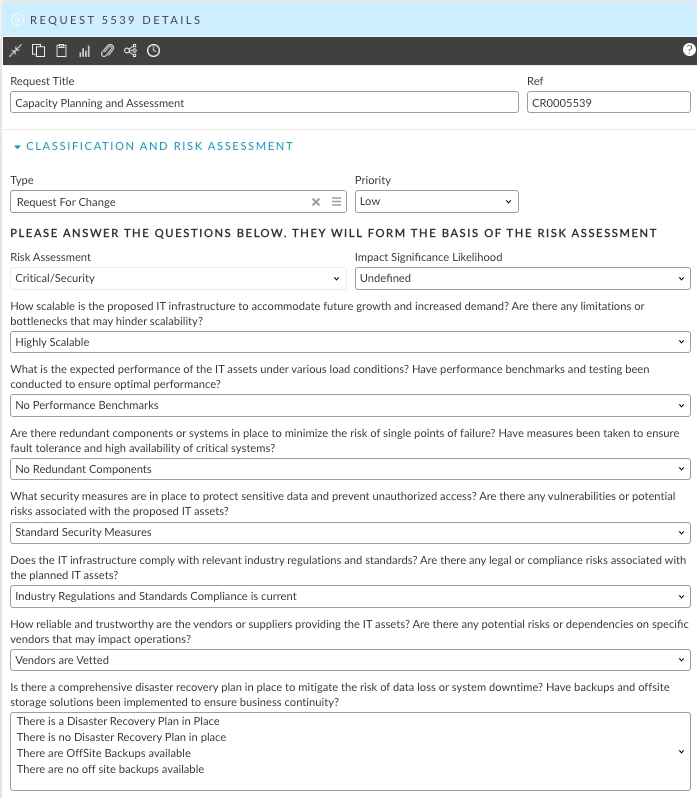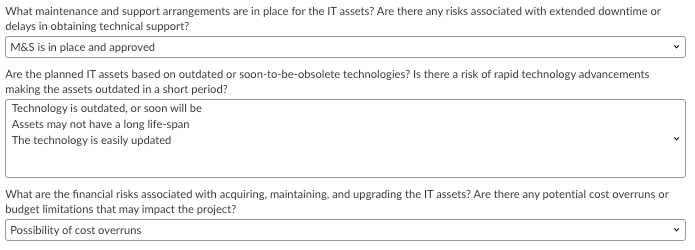Capacity Planning
When planning your IT asset capacity requirements, it's important to consider various risk factors that may impact your operations.
This section is designed to show you how to take the capabilities of ASM and leverage them to solve your own business and process issues. Each section gives a condensed, self-guided workshop on implementing the given capability. Many times, the content will refer you to specific ASM Product Documentation pages, rather than repeat what has already been documented.
How to Assess Risk in Capacity Planning
Assessing risks in capacity planning for IT Service Management involves identifying potential threats or uncertainties that may impact the ability to meet service demands and deliver optimal performance.
By systematically assessing and addressing risks in capacity planning, IT Service Management can proactively mitigate potential issues, optimize resource allocation, and ensure the ability to meet service demands effectively.
Here are some risk-related questions you should ask:
Scalability Risk:
How scalable is the proposed IT infrastructure to accommodate future growth and increased demand?
Are there any limitations or bottlenecks that may hinder scalability?
Performance Risk:
What is the expected performance of the IT assets under various load conditions?
Have performance benchmarks and testing been conducted to ensure optimal performance?
Redundancy and Fault Tolerance Risk:
Are there redundant components or systems in place to minimize the risk of single points of failure?
Have measures been taken to ensure fault tolerance and high availability of critical systems?
Security Risk:
What security measures are in place to protect sensitive data and prevent unauthorized access?
Are there any vulnerabilities or potential risks associated with the proposed IT assets?
Compliance and Regulatory Risk:
Does the IT infrastructure comply with relevant industry regulations and standards?
Are there any legal or compliance risks associated with the planned IT assets?
Vendor and Supplier Risk:
How reliable and trustworthy are the vendors or suppliers providing the IT assets?
Are there any potential risks or dependencies on specific vendors that may impact operations?
Disaster Recovery and Business Continuity Risk:
Is there a comprehensive disaster recovery plan in place to mitigate the risk of data loss or system downtime?
Have backups and offsite storage solutions been implemented to ensure business continuity?
Maintenance and Support Risk:
What maintenance and support arrangements are in place for the IT assets?
Are there any risks associated with extended downtime or delays in obtaining technical support?
Technology Obsolescence Risk:
Are the planned IT assets based on outdated or soon-to-be-obsolete technologies?
Is there a risk of rapid technology advancements making the assets outdated in a short period?
Budget and Cost Risk:
What are the financial risks associated with acquiring, maintaining, and upgrading the IT assets?
Are there any potential cost overruns or budget limitations that may impact the project?
By considering these risk questions, you can identify potential vulnerabilities and make informed decisions to ensure a robust and reliable IT asset capacity plan.
Implement A Capacity Planning Process in ASM
To set up a Capacity Planning Workflow in Alemba Service Manager, you can follow these steps:
Identify Workflow Stages
Design Process Flows
Reporting and Analytics: Define key performance indicators (KPIs) and metrics to monitor the effectiveness of capacity planning efforts.
Example Capacity Planning Workflow Template
Your capacity Planning Workflow template will typically take the form of several questions tied to the risk calculator that will then formulate the overall risk.
The workflow that sits behind the request and what you will do with the results, will be configured to follow your current process.


Last updated
Was this helpful?
